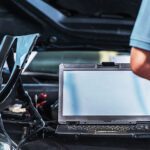Automotive Connector Applications in High Gear – SAE Highlights new connector technology

SAE Highlights new connector technology
Each year, the latest in automotive connector applications, developments, and requirements are examined in detail at the meetings of global automotive societies, including the Society of Automotive Engineers Congress and Convergence in the US; ZVEI in Europe; and the Japan Society of Automotive Engineers. Industry experts present and discuss potential solutions and developments for automotive engineering concerns raised through new proposed governmental emissions, safety and fuel economy regulations, end automotive customer wants, or proposals for the adaption of standard procedures. The recent SAE Congress held in Detroit highlighted the significance of a number of new connector technologies for safety, comfort, and performance applications.
Autonomous Vehicles
Nevada, California, and Florida have all passed laws allowing car companies, such as Toyota and Audi, to test self-driving cars on public roads, and several other states may follow suit. However, the National Highway Traffic Safety Administration says that while self-driving cars could have huge benefits for drivers in the long run, they should remain in the experimental phase for now. The agency “has considerable concerns” about certain rules being drafted by states and “does not recommend at this time that states permit operation of self-driving vehicles for purposes other than testing,” which indicates that regulators will not allow these cars to be widely used within the next few years. The NHTSA study will be completed within four years. In the meantime, Federal researchers are studying the expansion of other automated features, including automatic braking, that do not require the driver to give up control of the car, and are already being sold in high-end cars. NHTSA will decide by the end of 2013 whether to require automakers to put automatic braking technology into all cars.
The Intelligent Car Coalition, a new non-profit group consisting of AT&T, Hughes Telematics, Intel, the Association for Competitive Technology, Verizon, Microsoft, Facebook, Waze, Mitsubishi, Pioneer, Garmin, INRIX, ORBCOMM, and DENSO, aims to provide industry insight on public policy and engage federal policymakers in constructive conversations about the intelligent vehicle sector. The group suggested that “fully self-driving cars may be as little as five years away from the market.” This is somewhat more optimistic than NHTSA’s outlook.
Mitsubishi announced that it will invest roughly $10 million in Pioneer to strengthen its car navigation platforms and DENSO has released laser radar that helps vehicles avoid low-speed collisions. As automakers accelerate efforts to develop systems to avoid collisions, and reduce impact when a collision cannot be avoided, a significant number of new connector applications will be required.
Driver Distraction
During 2011, crashes involving distracted drivers killed 3,331 and injured an additional 387,000 people. The US Government describes distracted driving as any activity that could divert a person’s attention away from the primary task of driving, thus endangering drivers, passengers, and bystanders. This can include texting, using a cell phone or smartphone, eating and drinking, talking to passengers, grooming, reading (including maps), using a navigation system, watching a video, or adjusting a radio, CD player, or MP3 player. Many OEMs and Tier-1 suppliers are focusing on providing warnings to improve safety without desensitizing the driver.
Continental Corporation has demonstrated the Driver Focus Concept Car, a system that combines an infrared driver analyzer camera positioned in the vehicle’s steering column with an in-cabin optical guidance feature that is integrated with both the interior infrared camera to assist with driver distraction, and with ADAS technologies, to alert the driver to critical situations; radars, adaptive cruise control and lane departure warning, a driver analyzer camera; and the Halo system, to address the problem of driver distraction.
Other active safety and advanced driver assistance systems presentations at the SAE Congress included topics such as:
- Characterization of lane departure crashes using event data recorders extracted from real-world collisions
- Status of test methods for autonomous emergency braking systems
- Design and evaluation of emergency driving support using motor-driven power steering and differential braking on a virtual test track
- V2V-intersection management at roundabouts
Batteries
Significant discussions were held about lithium-ion batteries. Lithium-ion has been the winning type of rechargeable battery for the past decade. Hybrid and pure electric vehicles will be the largest value market for lithium-ion batteries over the coming decade as a whole, and certainly electric vehicles will dominate their use in later years. IDTechEx projects a market for traction batteries in land and water vehicles, as well as aircraft, of just under $60 billion in 2020, of which about 60% will be lithium-ion and 80% of those will be made by just four lithium-ion manufacturers.
The big question is which chemistry will dominate? Lithium has good temperature performance, a consideration in regard to safety. However, no lithium-ion cell is inherently safe, and the primary provider of safety is the battery management system (BMS), not the cell. Several recent fires and explosions have been related to something other than the cells.
The largest issue with lithium-ion chemistry is the overall battery cost. How far will lithium-ion battery costs fall in the electric vehicle sector? Common projections say a factor of three over the coming decade. Pike Research estimates about $523 per kilowatt hour by 2017. The current Nissan Leaf EV’s battery pack is reported to be only $375 per kilowatt hour, and Tesla Motors’ CEO Elon Musk has said that battery costs may drop to less than $200 per kilowatt hour in the near future. As battery cost improves, the production of plug-in hybrids and pure electric vehicles will increase dramatically, providing a significant increase for additional connector demand.
Fuel Cell Vehicles
The US Department of Energy is not giving up on hydrogen-fuel-cell electric vehicles and has plans to continue research and development and award funding for the alternative-propulsion strategy. Sunita Satyapal, director-hydrogen and fuel cells program at Fuel Cell Technologies Office, said at the Society of Automotive Engineers Government/Industry meeting, “Fuel cells are still an emerging industry and we all recognize both from the government side and the industry side that sustained commitment and investment is essential.” One major issue with fuel cell vehicles is safety. The hydrogen must be stored aboard the vehicle at extremely high pressure, creating concerns about passenger safety in the instance of a crash.
Daimler, Ford, and Nissan have announced plans to deliver an affordable FCEV to market within five years. Toyota and BMW recently formed a joint effort to mass-market FCEVs by 2017. Hyundai is planning an FCEV that is proposed to sell for about $46,000. GM engineers say production could occur in the 2015-2016 timeframe and, to that extent, GM has moved its New York-based FCEV unit to its Pontiac, Mich. powertrain-development headquarters. Fuel cell vehicles will most definitely require the development of new types of automotive connectors.
Other areas of automotive development discussed at the SAE Congress that will require innovative connector designs include:
- Vehicle dynamics, stability, and control (advanced fuzzy active steering control; torque vectoring control for electric vehicles with in-wheel motors using soft computing techniques; active kinematics suspension; coordination of steer angles, tire inflation pressure, brake, and drive torques for vehicle dynamics control)
- Driver vision and lighting technology (single-reflector full LED headlamp; automatic glare-free high-beam lighting devices for night driving; side-view cameras for reducing accidents)
- New technologies, including accurate instantaneous engine speed recording via an optical measurement system; magneto-elastic torque sensor for automatic transmission applications; transmission electro-hydraulic control module; MAGLEV driveline for wheeled fuel-cell-powered vehicles; and much more.
Systems Reliability: ISO 26262
It is highly recommended that connector suppliers become familiar with ISO 26262, the Functional Safety standard, which defines functional safety for automotive equipment. The first edition, published on November 11, 2011, was intended to be applied to electrical and/or electronic systems installed in “series production passenger cars” with a maximum gross weight of 3,500 kg. It aims to address possible hazards caused by the malfunctioning behavior of electronic and electrical systems.
The Functional Safety features form an integral part of each product development phase, ranging from specification to design, implementation, integration, verification, validation, and production release. The standard consists of nine normative parts and a guideline for the ISO 26262 as the 10th part. Like its parent standard IEC 61508, ISO 26262 is a risk-based safety standard, where the risk of hazardous operational situations are qualitatively assessed and safety measures are defined to avoid or control systematic failures and to detect or control random hardware failures or mitigate their effects.
ISO 26262 provides an automotive safety lifecycle (management, development, production, operation, service, decommissioning) and supports tailoring the necessary activities during these lifecycle phases. It covers functional safety aspects of the entire development process (including such activities as requirements specification, design, implementation, integration, verification, validation, and configuration) and provides an automotive-specific risk-based approach for determining risk classes (Automotive Safety Integrity Levels or ASILs, used for specifying the item’s necessary safety requirements for achieving an acceptable residual risk). It also provides requirements for validation and confirmation measures to ensure a sufficient and acceptable level of safety is being achieved.
VDC Research reports that adherence to ISO 26262 and AUTOSAR is expected to increase significantly in the next two years. Therefore, many functional safety service providers have created training programs to help understand the various safety processes as well as legal responsibilities and what is involved to achieve compliance. Failure to meet the ISO 26262 requirements, applicable throughout the lifecycle of all automotive electronic and electrical safety-related systems, may have severe consequences for the connector supplier.
As we can see from the many exciting developments discussed and presented at this year’s gathering, the recent SAE Congress in Detroit heralded a strong future for new automotive connector technology developments.
By Roger Rickey, Bishop & Associates Inc.





